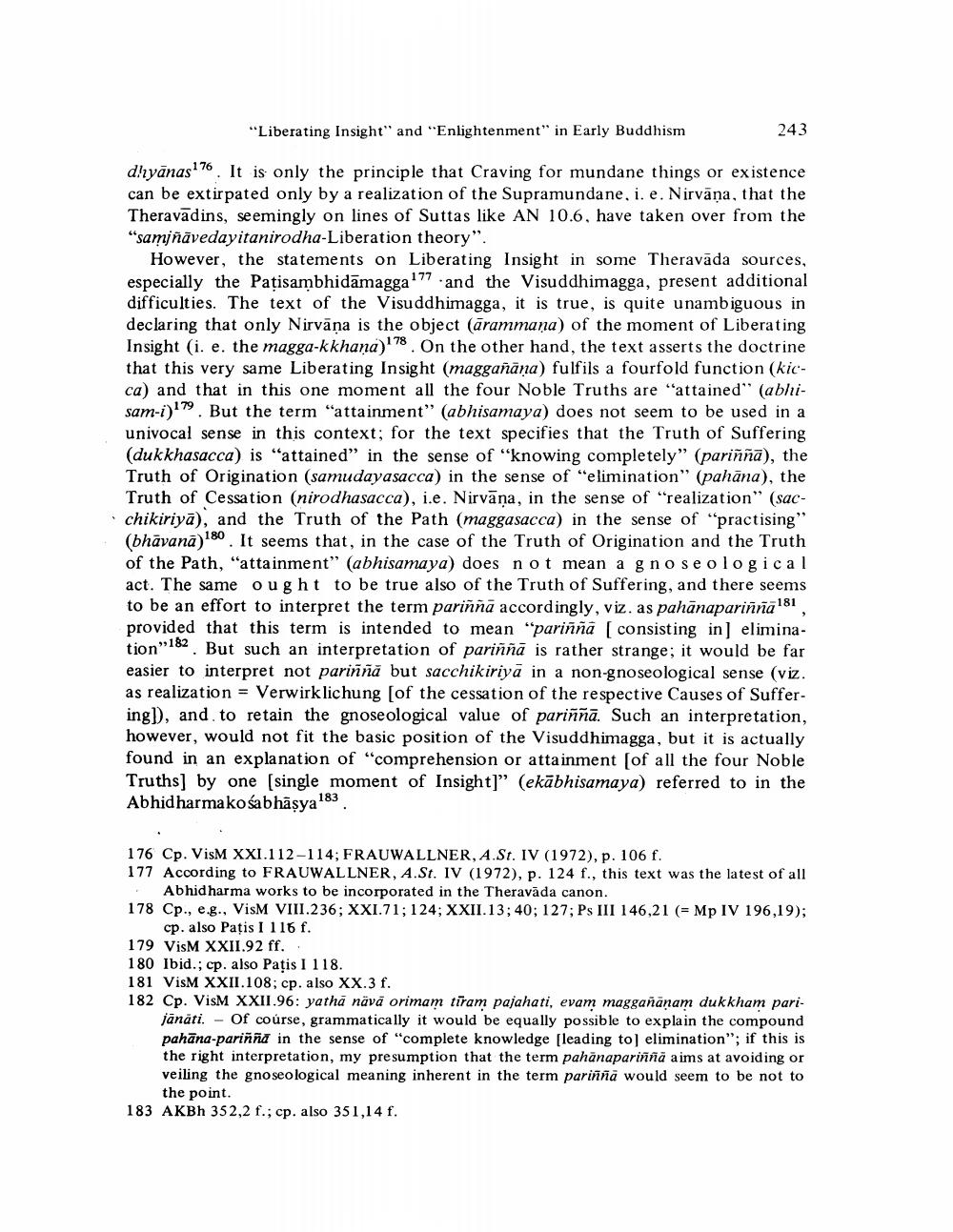________________
"Liberating Insight" and "Enlightenment" in Early Buddhism
243
dlyānas176. It is only the principle that Craving for mundane things or existence can be extirpated only by a realization of the Supramundane, i.e. Nirvāṇa, that the Theravadins, seemingly on lines of Suttas like AN 10.6, have taken over from the "samjñāvedayitanirodha-Liberation theory".
However, the statements on Liberating Insight in some Theravada sources, especially the Patisambhidāmagga"77.and the Visuddhimagga, present additional difficulties. The text of the Visuddhimagga, it is true, is quite unambiguous in declaring that only Nirvana is the object (ārammaņa) of the moment of Liberating Insight (i. e. the magga-kkhana) 78. On the other hand, the text asserts the doctrine that this very same Liberating Insight (maggañāņa) fulfils a fourfold function (kicca) and that in this one moment all the four Noble Truths are "attained" (abhisam-i)179. But the term "attainment" (abhisamaya) does not seem to be used in a univocal sense in this context; for the text specifies that the Truth of Suffering (dukkhasacca) is "attained" in the sense of "knowing completely" (pariññā), the Truth of Origination (samudayasacca) in the sense of "elimination" (pahāna), the Truth of Cessation (nirodhasacca), i.e. Nirvana, in the sense of "realization" (sacchikiriyā), and the Truth of the Path (maggasacca) in the sense of practising" (bhāvanā) 180. It seems that, in the case of the Truth of Origination and the Truth of the Path, "attainment" (abhisamaya) does not mean a gnoseological act. The same ought to be true also of the Truth of Suffering, and there seems to be an effort to interpret the term parinna accordingly, viz. as pahānaparinna 181, provided that this term is intended to mean "parinna ( consisting in] elimination"182. But such an interpretation of pariññā is rather strange; it would be far easier to interpret not pariññā but sacchikiriyā in a non-gnoseological sense (viz. as realization = Verwirklichung (of the cessation of the respective Causes of Suffering]), and to retain the gnoseological value of parinnā. Such an interpretation, however, would not fit the basic position of the Visuddhimagga, but it is actually found in an explanation of "comprehension or attainment (of all the four Noble Truths] by one (single moment of Insight]” (ekābhisamaya) referred to in the Abhidharmakosabhâsya 183
176 Cp. VisM XXI.112-114; FRAUWALLNER, A.St. IV (1972), p. 106 f. 177 According to FRAUWALLNER, A.St. IV (1972), p. 124 f., this text was the latest of all
Abhidharma works to be incorporated in the Theravada canon. 178 Cp., e.g., VisM VIII.236; XXI.71; 124; XXII. 13; 40; 127; Ps III 146,21 (= Mp IV 196,19);
cp. also Pațis I 116 f. 179 VisM XXII.92 ff., 180 Ibid.; cp. also Patis I 118. 181 VisM XXII.108; cp. also XX.3 f. 182 Cp. VisM XXII.96: yathā nāvā orimam tiram pajahati, evam maggananam dukkham pari
jānāti. - Of course, grammatically it would be equally possible to explain the compound pahāna-pariñña in the sense of "complete knowledge [leading to elimination"; if this is the right interpretation, my presumption that the term pahanapariññā aims at avoiding or veiling the gnoseological meaning inherent in the term pariññā would seem to be not to
the point. 183 AKBh 352,2 f.; cp. also 351,14 f.




